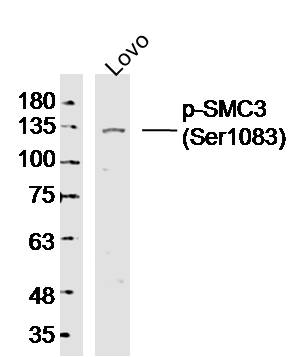
Rabbit Anti-phospho-SMC3 (Ser1083)antibody
SMC3 (phospho S1083); p-SMC3 (phospho S1083); CDLS2; DKFZp686L19178; DXhXs423e; DXS423E; KIAA0178; MGC138332; OTTHUMP00000061876; RP6 29D12.1; SB1.8; Segregation of mitotic chromosomes 1; Segregation of mitotic chromosomes like 1; SMC 1; SMC protein 1B; S
View History [Clear]
Details
Product Name phospho-SMC3 (Ser1083) Chinese Name 磷酸化基底膜相关软骨素蛋白多糖抗体 Alias SMC3 (phospho S1083); p-SMC3 (phospho S1083); CDLS2; DKFZp686L19178; DXhXs423e; DXS423E; KIAA0178; MGC138332; OTTHUMP00000061876; RP6 29D12.1; SB1.8; Segregation of mitotic chromosomes 1; Segregation of mitotic chromosomes like 1; SMC 1; SMC protein 1B; SMC-1-beta; SMC-1B; SMC1; SMC1A; SMC1alpha; SMC1alpha protein; SMC1B; SMC1B_HUMAN; SMC1BETA; SMC1beta protein; SMC1L1; SMC1L2; SMCB; Structural maintenance of chromosome 1 like 1 protein; Structural maintenance of chromosome 1 like 2 protein; Structural maintenance of chromosomes 1A; Structural maintenance of chromosomes 1B; Structural maintenance of chromosomes protein 1B. Product Type Phosphorylated anti Research Area Tumour Cell biology Signal transduction Cyclin transcriptional regulatory factor Epigenetics Immunogen Species Rabbit Clonality Polyclonal React Species Human, (predicted: Mouse, Rat, Dog, Pig, Cow, Horse, Rabbit, Sheep, ) Applications WB=1:500-2000 IHC-P=1:100-500 IHC-F=1:100-500 ICC=1:100-500 IF=1:100-500 (Paraffin sections need antigen repair)
not yet tested in other applications.
optimal dilutions/concentrations should be determined by the end user.Theoretical molecular weight 141kDa Cellular localization The nucleus Form Liquid Concentration 1mg/ml immunogen KLH conjugated synthesised phosphopeptide derived from human SMC3 around the phosphorylation site of Ser1083: SG(p-S)QS- Lsotype IgG Purification affinity purified by Protein A Buffer Solution 0.01M TBS(pH7.4) with 1% BSA, 0.03% Proclin300 and 50% Glycerol. Storage Shipped at 4℃. Store at -20 °C for one year. Avoid repeated freeze/thaw cycles. Attention This product as supplied is intended for research use only, not for use in human, therapeutic or diagnostic applications. PubMed PubMed Product Detail This gene belongs to the SMC3 subfamily of SMC proteins. The encoded protein occurs in certain cell types as either an intracellular, nuclear protein or a secreted protein. The nuclear form, known as structural maintenance of chromosomes 3, is a component of the multimeric cohesin complex that holds together sister chromatids during mitosis, enabling proper chromosome segregation. Post-translational modification of the encoded protein by the addition of chondroitin sulfate chains gives rise to the secreted proteoglycan bamacan, an abundant basement membrane protein. [provided by RefSeq, Jul 2008]
Function:
Central component of cohesin, a complex required for chromosome cohesion during the cell cycle. The cohesin complex may form a large proteinaceous ring within which sister chromatids can be trapped. At anaphase, the complex is cleaved and dissociates from chromatin, allowing sister chromatids to segregate. Cohesion is coupled to DNA replication and is involved in DNA repair. The cohesin complex plays also an important role in spindle pole assembly during mitosis and in chromosomes movement.
Subcellular Location:
Nucleus. Chromosome. Chromosome > centromere. Associates with chromatin. Before prophase it is scattered along chromosome arms. During prophase, most of cohesin complexes dissociate from chromatin probably because of phosphorylation by PLK, except at centromeres, where cohesin complexes remain. At anaphase, the RAD21 subunit of the cohesin complex is cleaved, leading to the dissociation of the complex from chromosomes, allowing chromosome separation.
Post-translational modifications:
Phosphorylated upon DNA damage, probably by ATM or ATR.
Acetylation at Lys-105 and Lys-106 by ESCO1 is important for genome stability and S phase sister chromatid cohesion. Regulated by DSCC1, it is required for processive DNA synthesis, coupling sister chromatid cohesion establishment during S phase to DNA replication.
DISEASE:
Defects in SMC3 are the cause of Cornelia de Lange syndrome type 3 (CDLS3) [MIM:610759]. CDLS is a dominantly inherited multisystem developmental disorder characterized by growth and cognitive retardation, abnormalities of the upper limbs, gastroesophageal dysfunction, cardiac, ophthalmologic and genitourinary anomalies, hirsutism, and characteristic facial features. CDSL3 is a mild form with absence of major structural anomalies typically associated with CDLS. The phenotype in some instances approaches that of apparently non-syndromic mental retardation.
Similarity:
Belongs to the SMC family. SMC3 subfamily.
SWISS:
Q9UQE7
Gene ID:
9126
Database links:Entrez Gene: 395188 Chicken
Entrez Gene: 9126 Human
Entrez Gene: 13006 Mouse
Entrez Gene: 399092 Xenopus laevis
Entrez Gene: 324475 Zebrafish
Omim: 606062 Human
SwissProt: Q9UQE7 Human
SwissProt: Q9CW03 Mouse
SwissProt: O93309 Xenopus laevis
Unigene: 24485 Human
Unigene: 14910 Mouse
Unigene: 11074 Rat
Unigene: 290 Xenopus laevis
Unigene: 75355 Xenopus laevis
Product Picture
Bought notes(bought amounts latest0)
No one bought this product
User Comment(Total0User Comment Num)
- No comment



 +86 571 56623320
+86 571 56623320
 +86 18668110335
+86 18668110335

